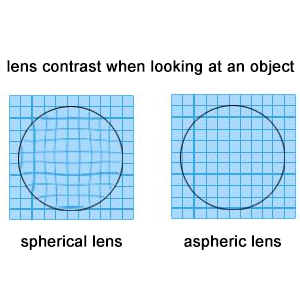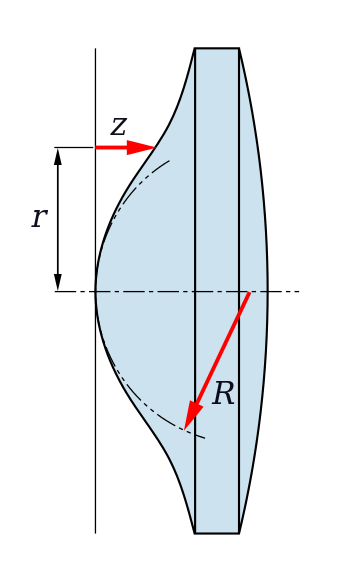*This post may contain affiliate links. This means we may make a commission if you purchase an item using one of our links*
Unlike traditional lenses, an aspheric eyepiece does not have a spherical surface. This non-spherical surface is able to correct aberrations, often leading to more improved and cheap optical results. Aspheric eyepieces are often used in glasses, telescopes, and other optical objects as a result.
Whether you are a fan of telescopes or need eyeglasses yourself, learning more about aspheric eyepieces can come in handy. Keep reading to learn more about these non-spherical eyepieces, their history, and their pros and cons.
How Does An Aspheric Eyepiece Work?
Table of Contents

As we learned above, an aspheric lens does not have a spherical or cylindrical surface. What this means is that the aspheric lens has more shape than a simple lens. Instead, the surface can have more of an ellipse, parabola, or hyperbola shape.
It may be helpful to compare the aspheric lens to a regular lens. A regular lens has a perfectly round top. In comparison, an aspheric lens can have dips or bulges, making the lens not perfectly round. The fact that the lens is not perfectly round is what makes the lens aspheric.
Sometimes, eyepieces have more than one lens. By stacking different lenses, the final result can be as perfect as possible. As the light travels through the various lenses, the ray is bent. By the time the ray exits the final lens, the vision is perfected or at least nearly perfected.
Because of the different shapes, aspheric lenses can correct optical spherical aberrations. Spherical aberrations occur whenever light rays focus on different points at the same time. The result is a blurry image. One of the most common examples of spherical aberration is astigmatism.
Since aspheric lenses are designed to minimize spherical aberrations, they are often used for individuals with astigmatism. With these lenses, vision and astigmatism can be corrected for better eyesight.
Who Created The Aspheric Eyepiece?
The aspheric lens was invented in the late 1660s by Francis Smethwick. The lens was presented to the Royal Society shortly after creation, but it is unknown if they were created in 1667 or 1668. Though the year is unknown, we do know that the eyepieces were shown to the Society on the date of February 27.
When it was first shown, the aspheric lens had three aspheric elements. The viewers reported that this lens did a better job at representing objects in their actual proportions and colorings than traditional spherical lenses.
It wasn’t until years later that the aspheric lens was used on an eyepiece. Moritz von Rohr was the first person to design eyeglasses with aspheric lenses, but it wasn’t until the 1950s that the lens went mainstream and was used for movie purposes. Since then, the popularity of aspheric lenses has boomed.
When Should You Use An Aspheric Eyepiece For Astronomy?

Many astronomers use aspheric eyepieces for their affordability and efficiency.
On the one hand, these eyepieces are very effective since they correct spherical aberrations. When looking at the stars, even the slightest aberration can make it difficult to see off in the distance.
On the other hand, aspheric lenses are highly affordable. Back in the day, the odd shapes of aspherical eyepieces made them expensive, but they are now highly affordable. In fact, some aspheric eyepieces are even cheaper than plossl lenses, the sort of lenses that come with standard telescopes.
Of course, aspherical eyepieces are not as good as ethos, nagler, and delos, for these are the most superior eyepieces in terms of design, image quality, and field of view.
Unfortunately, these superior eyepieces are highly expensive, making them primarily suited for professional or serious astronomers.
Flat field, kellner, Plossl and a number of other eyepieces are better or worse in some aspects too.
Because of these facts, aspherical eyepieces are great for casual astronomy, especially if you need extra eye relief. Though they might not be as powerful as some eyepieces, they are much more affordable while still offering great vision and eye relief.
Check out this list of ours if you’re interested in doing a bit of stargazing.
The Pros Of An Aspheric Eyepiece
The biggest benefit of aspheric eyepieces is that they correct spherical aberrations without costing a fortune. Most eyepieces that offer any type of worthwhile eye relief are 10 times more expensive than the aspheric eyepiece.
At the same time, these eyepieces are much more effective than other low-budget lenses, all while being more affordable too.
Because of how affordable these lenses are, they are relatively easy to find. You shouldn’t have much trouble finding these sorts of eyepieces at astronomy stores in person or online. You might even be able to find these eyepieces at regular stores too.
The Cons Of An Aspheric Eyepiece
The biggest drawback of aspheric eyepieces is that they are difficult to mold with traditional lens molding processes, which explains why it took so long for the lens to get popular.
Luckily, this drawback has largely been sidestepped by more recent molding processes.
Another drawback is that the visual quality of these eyepieces isn’t as superior as high-end lenses. At least they are better than other low-budget lenses, like the ones that often come with telescopes, while being more affordable than the superior options.
Summary
Ultimately, an aspheric eyepiece is one that lacks the classic spherical surface on the lens. In contrast, it has more technical shapes that help to correct any spherical aberrations, such as astigmatisms.
Because of the corrective powers, aspheric eyepieces offer great vision.
Although the visual quality isn’t quite as superior as other expensive models, aspheric eyepieces are still decent and super affordable. The affordability makes them a great go-to eyepiece for casual astronomical uses, such as stargazing.
References
https://en.wikipedia.org/wiki/Aspheric_lens
https://www.edmundoptics.com/knowledge-center/application-notes/optics/all-about-aspheric-lenses/

